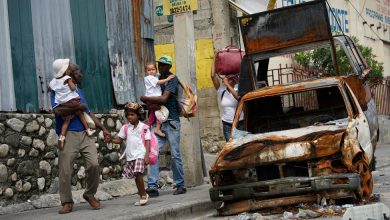They Earn Tens of Thousands by Turning in Idling Trucks

Good morning. It’s Tuesday. Today we’ll find out about urban bounty hunters who search for trucks that are parked with their engines running. We’ll also look at a photographer’s images of encounters during the pandemic.

Credit…Sarah Blesener for The New York Times
New York City has a clean-air program that allows people to report commercial vehicles that are parked and idling for more than three minutes, or one minute outside a school. Those who report infractions by submitting a video can collect 25 percent of the fine collected by the city — $87.50 on a $350 fine.
This has given rise to a particular breed of urban bounty hunter — people who hunt down idling trucks and shoot videos, sometimes surreptitiously. I asked my colleague Michael Wilson, who wrote about people who do this, to explain.
Are they environmentalists or bounty hunters? What’s uppermost in their minds, clean air or the money they stand to make because the city gives 25 percent of the fines to those who report infractions?
These “idling warriors” are pretty up front about how great the money can be. But they are also very passionate about clean air. One man I spoke to, Ernest Welde, actually became an environmental lawyer to address air pollution. He was confronting idling truck drivers for years before this program came about. So it goes both ways.
These people are urging the city to raise fines, which would increase their bounties, to be sure, but also because they believe the current fine schedule is too low for a company like Amazon to really care about.
How much do they make doing this in, say, a year? Is it enough that they’re living on the money they make?
For everyone I spoke to, this is a side gig — just extra money in their pockets. For instance, the lawyers I spoke to have full-time jobs already. And the retired guys I met seemed to be living comfortably before the program.
But one of them, Paul Slapikas, said he pulled down $64,000 last year, which is certainly not nothing. I actually think other people make more than that, but several bounty hunters declined to share that information with me.
One shorthand estimate is the fact that about 20 people collected most of the $700,000 paid out last year, some more than others.
How much of a problem are idling trucks? How much are they contributing to air pollution, especially when they idle longer than three minutes?
This is a tough one, I found. There are no go-to studies that I’m aware of — and I could be wrong — that get at this question.
But there is no shortage of reports on the health ramifications of breathing in the kinds of pollutants associated with exhaust fumes. A pediatrician I spoke to warned of the effects of these fumes on children, who can suffer lifetime issues.
People in the trucking industry point out that emissions are far, far cleaner than in decades past. But it’s still illegal to idle for excessive periods.
How dangerous is making videos of trucks like this? Some of the people you interviewed said they’d been assaulted.
I think the danger element is pretty rare, but when it surfaces, it sounds stressful, yes. One encounter led to a lawsuit. A guy who was filming a truck claims the driver and his co-workers knocked him down.
There’s no question that it gets your adrenaline going, making this secret video and being close enough to a truck to capture the engine noise without being noticed. I loved seeing all the strategies to disguise what you’re doing. One man puts the phone in his shirt pocket while it’s filming. Another pretends he’s on a FaceTime call. And Paul Slapikas has a whole routine with props, while the phone that’s recording is not even in his hands.
Weather
It will be a mostly sunny day with temperatures in the upper 50s, and a partly cloudy evening dipping to 40.
alternate-side parking
In effect until April 14 (Holy Thursday).
Challenging a DNA database
The New York Police Department instructs detectives to offer something — water, soda, a cigarette or gum — to people they are questioning about a crime and to collect the cup, can, butt or wrapper when they leave. The DNA is collected, tested and entered into a city database.
The Legal Aid Society said in a class-action lawsuit filed on Monday that the database violates state law and constitutional protections against unreasonable searches. The lawsuit calls for DNA profiles that lawyers argue were gathered illegally to be deleted and for the database to be shut down.
Sgt. Edward Riley, a police spokesman, said in a statement that officials believed the use of DNA followed the law.
New York State law requires a conviction or a court order before someone’s DNA can be stored in a state-run databank. But the city’s database includes DNA from people like Shakira Leslie who have been arrested or questioned but not convicted. Leslie, 26, was a passenger in a friend’s car that the police pulled over for a traffic infraction in the Bronx in 2019.
The police searched her and found nothing illegal. But when the officers found a gun in another passenger’s bag, everyone in the car was arrested, charged with possession of a weapon and taken to a precinct. There, she was given a cup of water.
She was released hours later, and the weapons charge was dropped. Later she learned that the police had taken her DNA from the cup without asking. They later tested it and used it to rule her out as a suspect.
“I was shocked, upset,” said Leslie, who is a plaintiff in the Legal Aid lawsuit. “I just felt violated. I completely lost trust for N.Y.P.D.”
The latest New York news
-
Top New York State officials said they did not expect the Omicron subvariant BA.2 to spur a serious spike in cases in the state.
-
Saigon Social, a Vietnamese restaurant on the Lower East Side, has only existed in pandemic-era limbo. We spent three months with its owner, Helen Nguyen.
Photographing personal space in the pandemic
Soon after the term “social distancing” entered the language, the photographer Renate Aller decided to document what staying six feet apart from other people looked like. She invited friends over, one at a time, or invited herself to where they live. Either way, she stayed outside. She placed two chairs on the sidewalk in front of her building in SoHo — or theirs, when she went visiting — and put her camera across the street, setting the timer to take nine shots, with three seconds between each one.
Then she crossed the street, walked into the pictures and sat down. Sometimes she and the other person in each image looked into the camera. Sometimes they looked at each other. Sometimes they danced. Always they were six feet apart — thus the title “Sidewalk, 6’ Apart in New York City” for an exhibition of the photographs at the New-York Historical Society.
It was the first time in weeks that many of the people in the photographs had encountered others in the outside world. Aller contrasted those early weeks of the pandemic with the first few weeks after the Sept. 11 attacks that destroyed the World Trade Center in 2001. Then, Aller said, “People were scared to be outside. This was the opposite. We were scared to be inside.”
What we’re reading
-
Curbed wrote about how a small boat became the Gowanus Canal’s most recent victim.
-
A 1964 Andy Warhol silk-screen of Marilyn Monroe will be auctioned for an estimated $200 million, which would make it the most expensive 20th-century artwork ever to sell at auction.
-
What we’re subscribing to: “Where should we eat?” is the age-old question. Nikita Richardson, a food editor for The Times, has answers for diners in New York City. Every Tuesday starting today, this subscriber-only newsletter (with a four-week free trial for nonsubscribers) will feature recommendations, from new places to beloved classics. Sign up here.
METROPOLITAN diary
March 2020
To mark the two years of the pandemic, this week’s Metropolitan Diary entries features reader tales of life in New York City during the pandemic.
Dear Diary:
I was working at a coffee shop in Midtown near Grand Central Terminal in early March 2020. Toward the end of the morning rush one day, I turned around from the counter to take care of some basic tasks that had been neglected in the chaos.
When I turned back, I saw it: a single N95 mask, wrapped in plastic, on top of the pastry case.
I asked a man who was waiting for the cappuccino he had ordered whether it belonged to him.
He shook his head. So did the other people in the line.
Whoever had left it was gone or didn’t want to be identified — a stranger who, in the middle of panic and confusion, saw me and chose to help.
— Grace Brunson
Illustrated by Agnes Lee. Send submissions here and read more Metropolitan Diary here.
Glad we could get together here. See you tomorrow. — J.B.
P.S. Here’s today’s Mini Crossword and Spelling Bee. You can find all our puzzles here.
Melissa Guerrero, Jeff Boda and Ed Shanahan contributed to New York Today. You can reach the team at [email protected].
.




